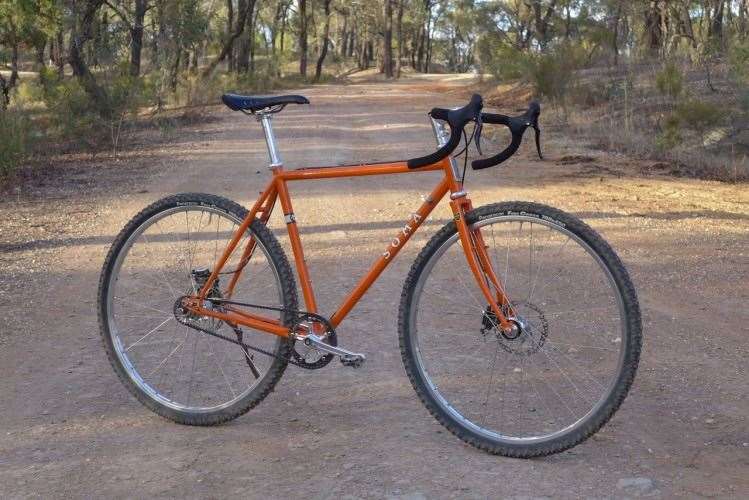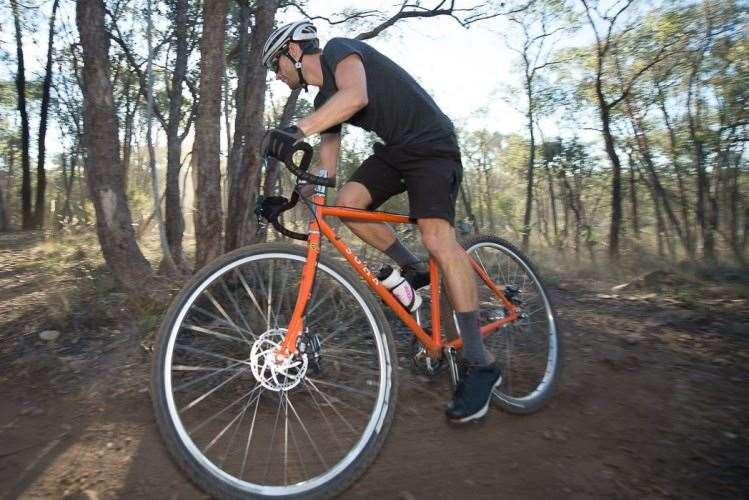TESTED: TRP Hy/Rd Disc Brakes
Hydraulic disc brakes have clear advantages over mechanical, but don't suit all purposes. TRP's Hy/Rd is a great solution.
Despite the clear advantages though, there are still barriers to the adoption of disc brakes by our drop-bar cousins.
Some riders just flat-out don’t want them, citing the fact that they have no problem with locking up their tyre with a standard rim calliper. If you’re old enough to remember when disc brakes were first introduced to mountain bikes, you’ll find that argument uncannily familiar. However, as we all know, disc brakes aren’t about having more power; they’re about delivering the same power with less effort.
Another barrier to equipping road/cross bikes with disc brakes has been the expense. Road mechanical disc brakes have been around for some time, and they’re compatible with regular STI road brake/shift levers as well as being available for a pretty decent price. However, hydraulic brake systems require a completely redesigned lever, which adds significantly to the overall cost. While both Shimano and SRAM both offer dedicated road hydraulic brake solutions, the uptake in the aftermarket hasn’t been as swift as some might have predicted, and cost is likely a large part of that equation.
 The Soma Wolverine was built with TRP Hy/Rd Disc Brakes.
The Soma Wolverine was built with TRP Hy/Rd Disc Brakes.TRP claim that the Hy/Rd was built to bring more affordable hydraulic performance to the developing road and cross disc market. Released almost exactly 2 years ago, the Hy/Rd (pronounced “High Road”) brakes have been a roaring success both in the aftermarket and OEM market.
The original concept was to build a hydraulic brake calliper that is compatible with existing road STI brake/shift levers, so that riders could enjoy better braking quality without having to shell out for a whole new system.
Given its unique design and wide range of applications, I decided to put the TRP Hy/Rd brakes to the test on our Soma Wolverine long-term test bike.
But is the Hy/Rd just a convenient solution to the current growing pains of the road/cross disc brake market? Or does it have the performance to stand out on its own?

Hybrid Construction
In its most simple explanation, the Hy/Rd brake is a cable-actuated hydraulic disc brake. It uses a hydraulic brake calliper with a dual-piston design that clamps both brake pads onto the rotor.
However, rather than locating the master cylinder up in the brake lever on the handlebar, TRP combine the master cylinder with the calliper into the same piece of forged alloy. The main piston is then secured by a small mechanical arm, which is actuated by a normal brake cable.
Aside from its simplicity, there are actually several side benefits to this design. Because there is no hydraulic hose, there are fewer opportunities for potential air bubbles to hide and cause issues. The brakes are also easier to bleed from a mechanic’s perspective, as both ports are located in the same area.

Like all Tektro and TRP brakes, the Hy/Rd’s run on Mineral Oil. If you do need to bleed them, TRP offer a specific bleed kit to do so.
Out of the box, the Hy/Rd’s come equipped with mounting hardware and your choice of a 140mm or 160mm rotor. The discs are TRP’s own stainless steel 6-bolt design. However, the semi-metallic disc brake pads use the same profile as Shimano’s M525 disc pad design. This offers up plenty of aftermarket replacement pads, but it also means you can run the Hy/Rd brakes with Shimano rotors too.
Our test brakes weighed in at 190gm apiece, which is slightly under the claimed weight. Rotors come in around the 100gm mark for a 160mm diameter.
Installation & Setup
If you’re already running mechanical disc brakes, the Hy/Rd are a plug ‘n’ play item. Simply unbolt your existing callipers, bolt on the Hy/Rd’s, and link it all up with your existing brake cable. The callipers will mount directly to a 160mm post mount, or in my case, with 160mm IS adapters for the Wolverine frame and fork.

To help you attach the brake cable, there’s a small lever lock that screws into the actuation arm, which holds the piston in place while you secure the brake inner wire. This same lever lock can be used when the wheels are removed from the bike, in order to prevent the pads coming together if the brake levers are accidentally pulled on.
Once the cable is attached, an inline barrel adjuster helps to get the final lever throw to the desired position. With decent pad clearance, the Hy/Rd’s are straight forward to align over the top of the rotor.
If you need more guidance with installation, TRP also provide a fantastic video on their website on how best to setup the Hy/Rd brakes.
The build on my Soma Wolverine test bike saw the Hy/Rd brakes paired up with the TRP RRL singlespeed brake levers, which use a beautifully shaped alloy lever that is black anodized. These levers look good, they have a grippy textured surface for the rubber hoods, and they deliver great feel along with the Hy/Rd disc brakes. Unfortunately they don’t offer reach adjustment, but even with my small carnie-hands, I had no trouble with setting them up properly.

One important aspect of running any brake system that relies on a steel cable is ensuring you have high quality housing and a slick inner wire. In my case, I’ve had the pleasure of testing the Yokozuna Reaction brake cable system, which has played a significant part in the performance of the Hy/Rd brakes.
The Yokozuna Reaction kit features a RapidWire compression-less housing that is pre-lubed to ensure slick performance. Under hard braking, the firm outer cable resists compression and flexing, which means you get stronger braking and better feedback through the levers. Whether you’ve got V-brakes, mechanical discs or the Hy/Rd brakes, the Yokozuna Reaction cables come highly recommended.
Smooth Modulation
Having used numerous mechanical disc brakes over the years including Avid BB7s, BB5’s, and various models from Tektro and Shimano, it didn’t take much trail time to realise that the Hy/Rd’s are quite simply on another level.
However, I must admit that I was initially sceptical of the Hy/Rd brakes. I’ve found that a well setup mechanical disc brake can be pretty good, with the BB7’s being some of my favourite. With their bulky shape and the fact that they are still actuated by a cable, I really questioned where the need was for the Hy/Rd. But from the very first corner, it became apparent that I was going to be eating humble pie. Sweet, delicious, humble pie.

With the hydraulic actuation and the twin-piston design, the Hy/Rd’s offer a smoother braking feel that pays dividends off road. A lot of mechanical brakes are guilty of feeling ‘grabby’, because there is more guesswork between when the pads first engage and when they lock up the wheel. With the Hy/Rd’s, they seem to deliver a more linear feel that offers a much more controllable range throughout their braking.
You get better feedback through the levers, and it’s much easier to tip-toe the line between powerful braking and wheel lock-up. As a result, I experienced less skidding and less chance of the front tyre giving way mid-corner due to panic braking. Given I’ve been riding them on a rigid singlespeed Monster Cross bike, that control is all the more important.

All Weather Braking
I’ve been testing the Hy/Rd brakes for over 6 months now, with plenty of ride time that has encompassed commuting, wet-weather road riding, trail riding and XC racing. The brakes have largely been flawless throughout that period, with no fading or loss of power.
They also feel as smooth as they did on the first ride. Of course the Hy/Rd brakes are still susceptible to water and grime entering the cables, but the fully sealed calliper does ensure they’re more consistent in muddy ‘cross races compared to a mechanical disc brake.
Like other hydraulic systems, the Hy/Rd’s will compensate for pad wear, so that the lever throw stays the same as the pads wear over time. The stock semi-metallic pads are a good compromise between braking noise and wet-weather durability, though I’d recommend going to a full metallic compound for dedicated winter riding.

Corrupted By Power?
If I had one complaint about the Hy/Rd disc brakes, it would be that they delivered a little too much power with the 160mm rotors on my Soma Wolverine test bike. When I was really on the anchors, the powerful front brake overwhelmed the slender steel tubing of the fork, causing a heavy shuddering sensation as the fork flexed back and fourth. The rear brake had no such issues.
This is obviously not the Hy/Rd’s fault, but it is still something to take into account when choosing your braking setup. I believe that 140mm rotors would be ideal for most riders needs, though heavier riders and those doing loaded off-road touring will welcome the extra power of the 160mm setup.
I did experience a very small amount of noise from the Hy/Rd brakes when more of my ride time involved bitumen, but again this is a symptom of a light rider not running the brakes as hard as they should be. In the latter part of the test period, I tried out some Shimano Resin brake pads, which eliminated the noise completely and better suited the dry riding conditions.
Refined Performance
It’s worth noting that TRP introduced some running changes with the Hy/Rd brake in late-2014. The general architecture remains the same, but the newer version features a larger reservoir with more oil for better heat compensation. A new rubber gasket also assists with reducing stiction for smoother operation.
If you’re wondering what brakes you’ve got, the newer production brakes (available since September 2014) can be identified by the Mineral Oil label being printed on the outside of the master cylinder.

After testing the Hy/Rd disc brakes, I can happily report that they exceeded my expectations. They’re powerful brakes for sure, but it’s the delivery of their power and the consistency of the braking feel that makes them a real winner.
They are on the heavy side, and their bulky aesthetics won’t be to everyone’s taste. They can also be tricky to fit to some frames that mount the calliper inside the rear triangle. However, if you can fit them with good quality housing and the right rotor size for your application, you’ll enjoy excellent braking feel and modulation that leaves its mechanical competitors in the dust.
TRP haven’t just produced a convenient solution for the road/cross disc revolution, they’ve produced a quality product that has reset the performance bar.
Hits
- Smooth and consistent braking feel
- Great modulation
- Compatible with Shimano pads
Misses
- Not particularly light
- Bulky
- 160mm rotors can overpower lightweight forks
Brand: TRP (Tektro Racing Products)
Model: Hy/Rd Disc Brakes
RRP: $189 per end
Website: www.adventurebrands.com.au







